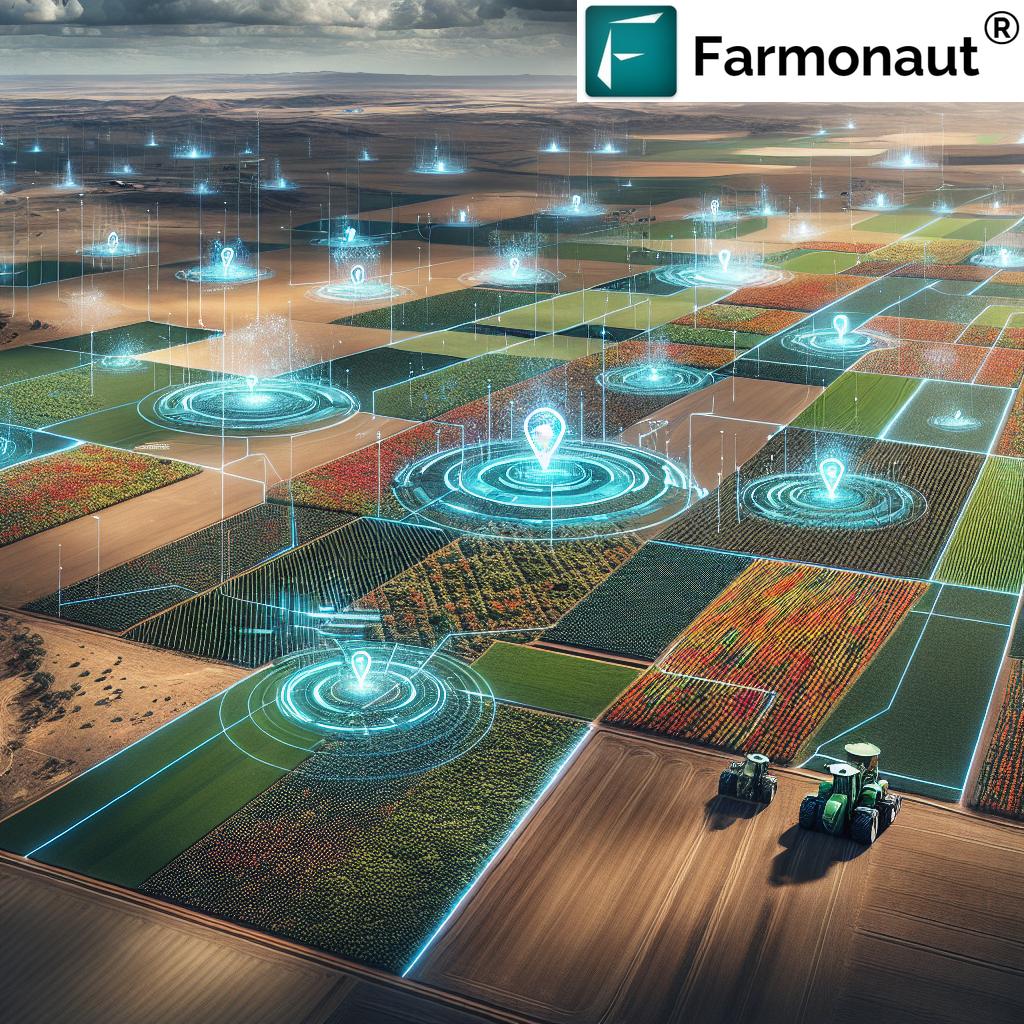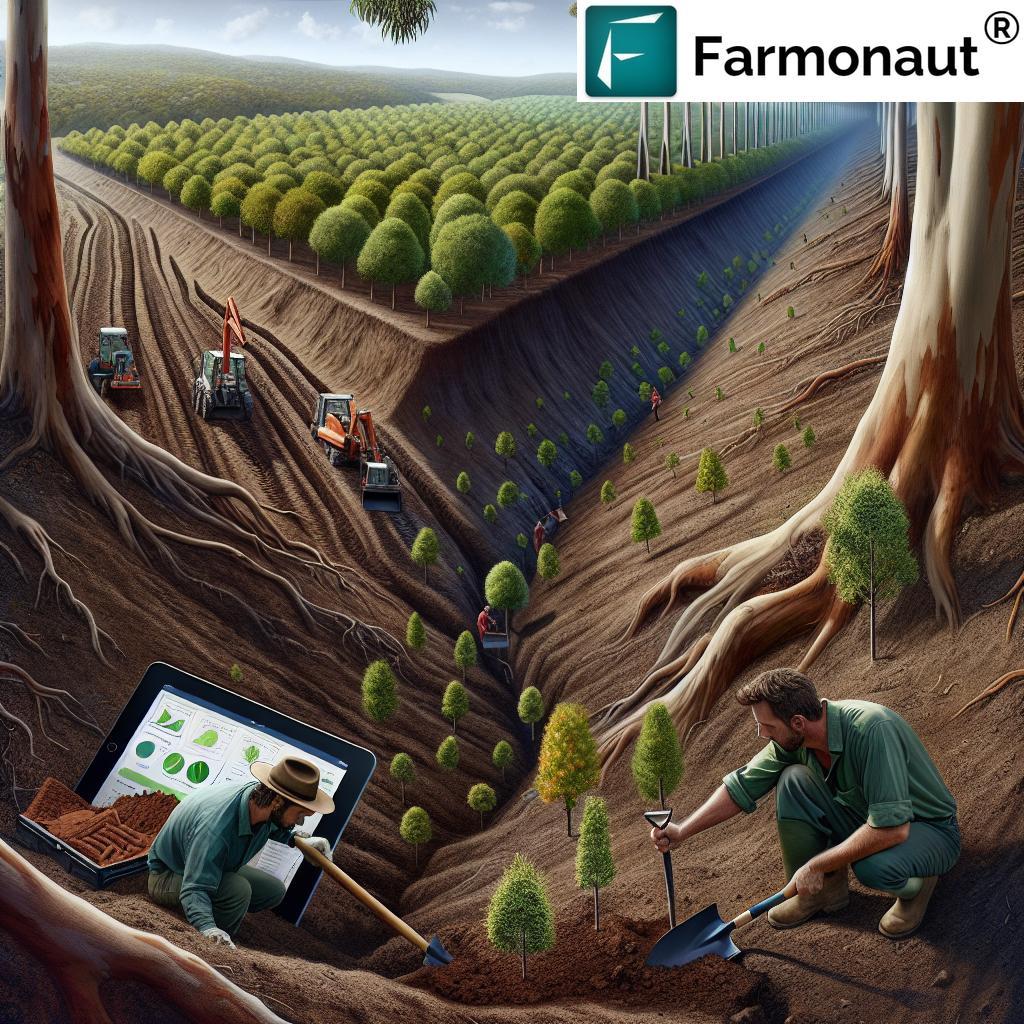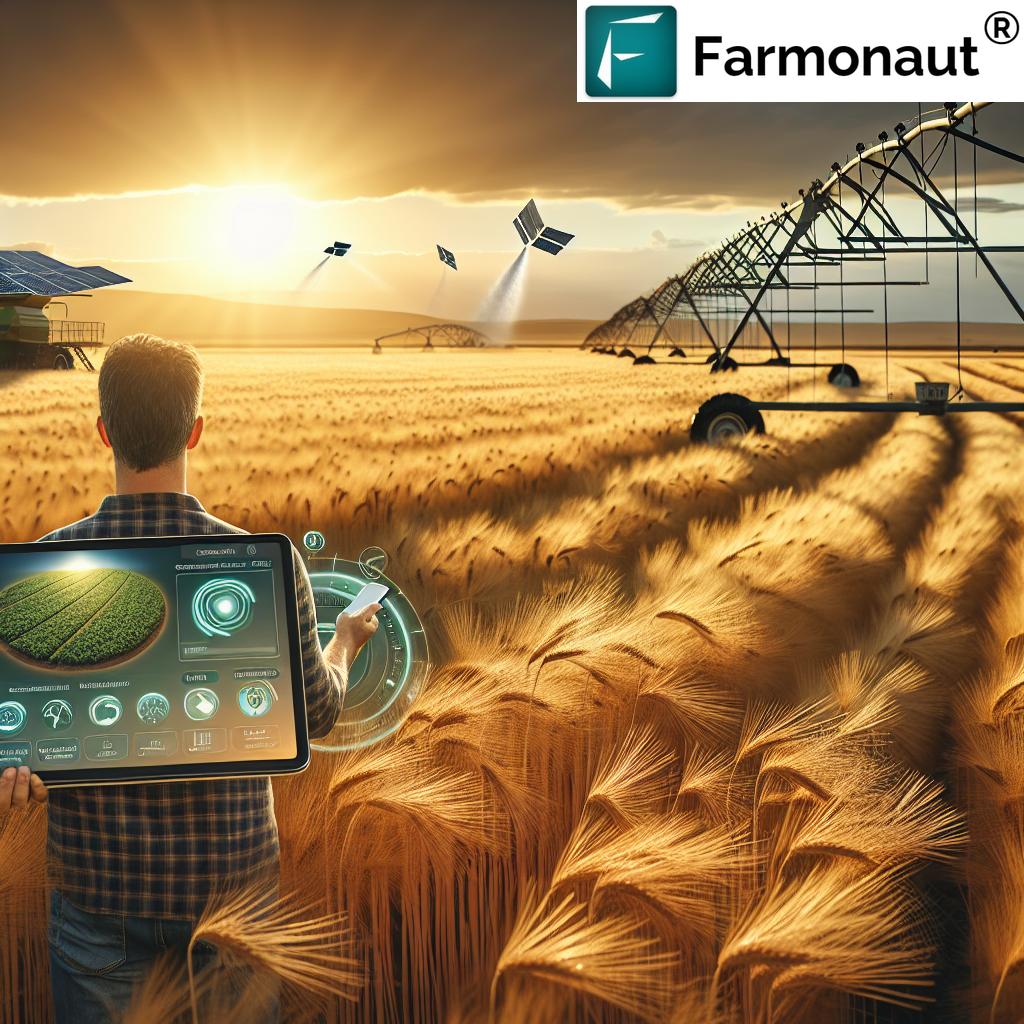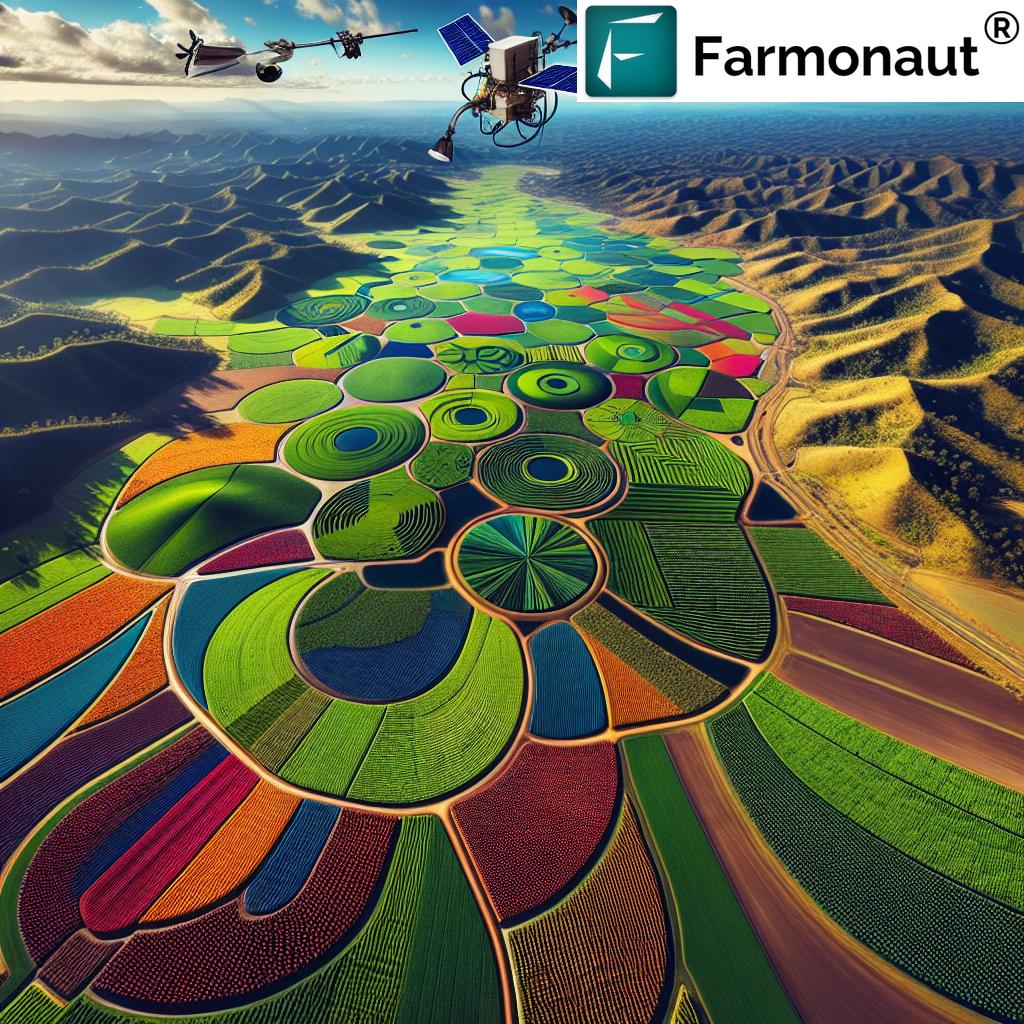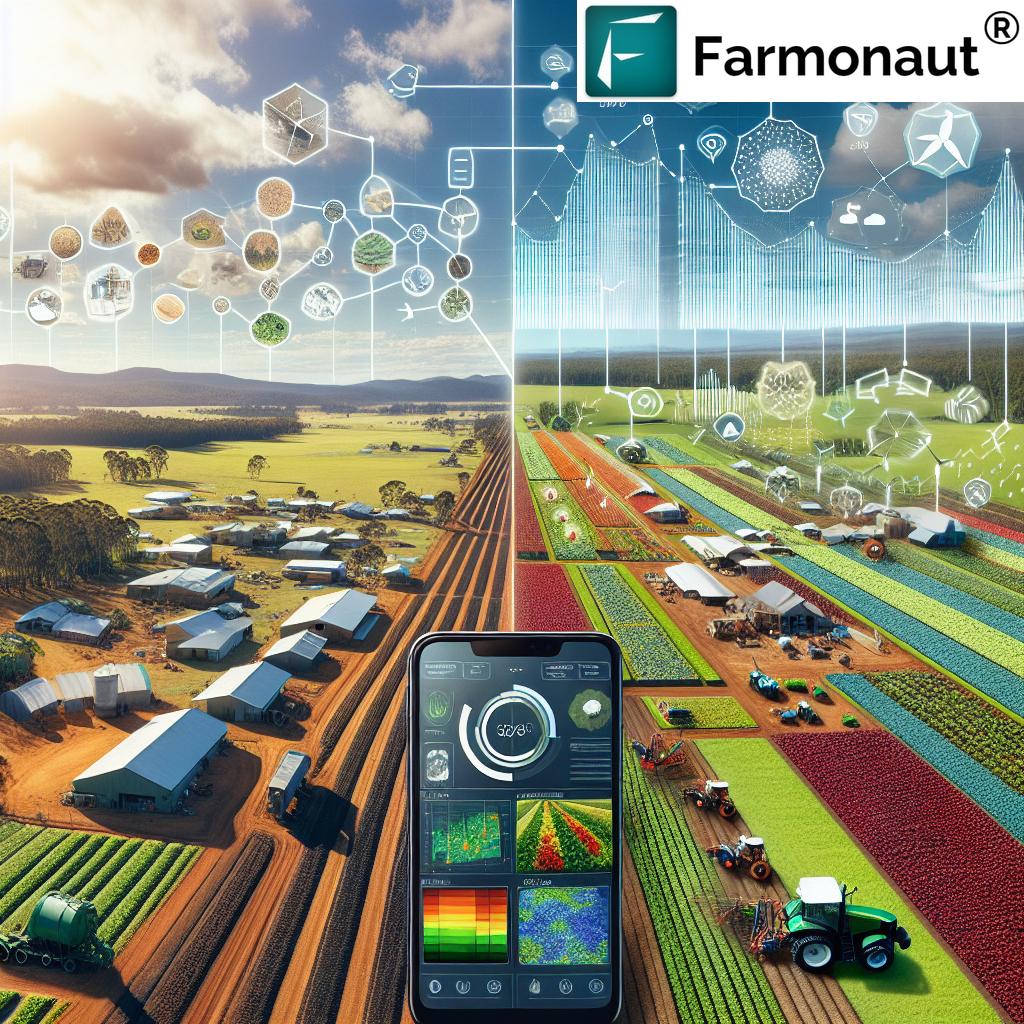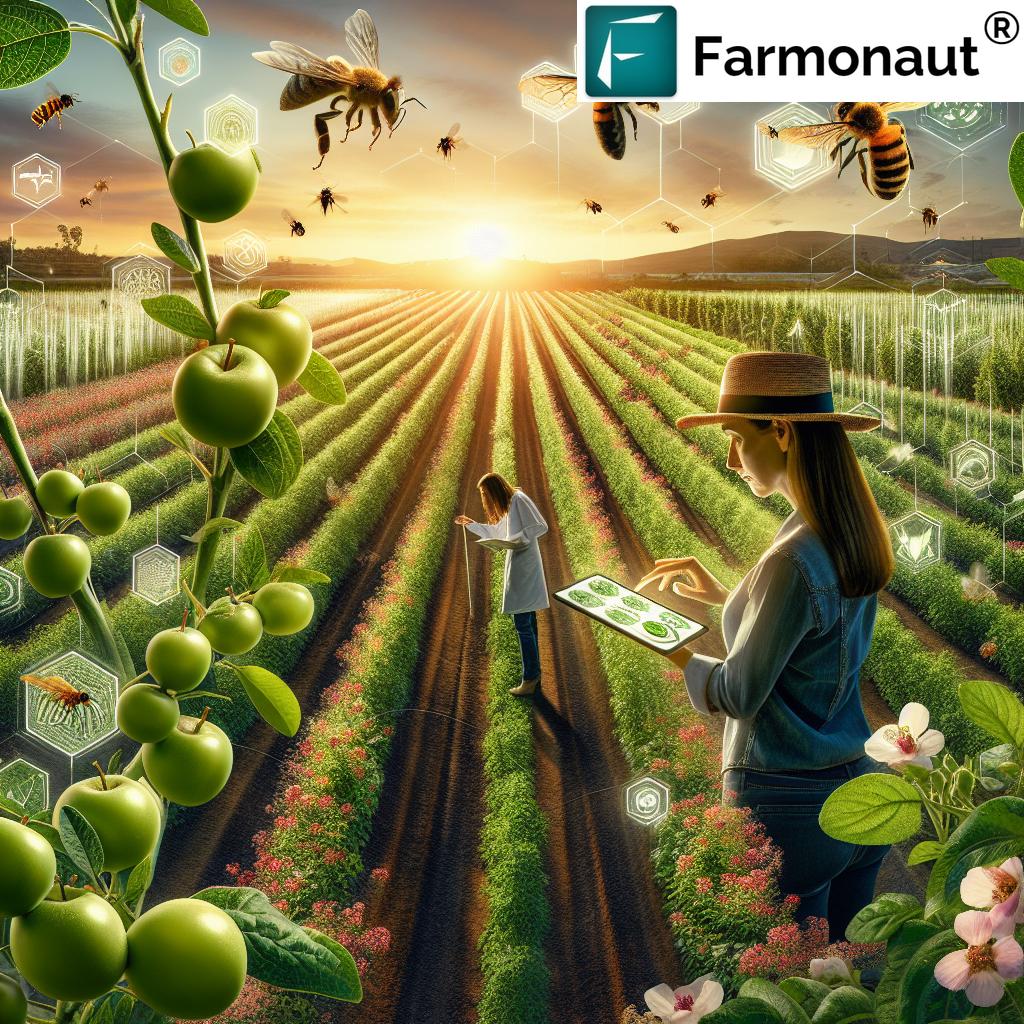Table of Contents
- Introduction: The Heart of Australia’s Rural Economy
- Australian Rural Industries: An Overview
- Australian Rural Industries: 7 Innovations for Sustainability
- Comparative Innovations Impact Table
- Challenges, Resilience, and Future Outlook
- How Farmonaut Empowers Australian Rural Industries
- FAQ
- Conclusion
“Australia’s agriculture sector contributes over $60 billion annually, with 55% of land managed under sustainable practices.”
Australian Rural Industries: 7 Innovations for Sustainability
Australia’s rural industries represent the backbone of the nation’s economy and identity. From agriculture and farming covering vast hectares of arable land, to forestry in australia and the rapidly growing australian aquaculture industry, these sectors deliver a diverse array of products essential for domestic consumption and export. Modern challenges—climate change and australian agriculture, resource scarcity, and shifting global markets—demand not only resilience but relentless innovation.
In this comprehensive guide, we dive deep into seven groundbreaking innovations powering the transition to sustainability across Australia’s rural sectors. Using a combination of technology, tradition, environmental respect, and smart management, the country’s farming and forestry operations set a global benchmark for a sustainable future.
Australian Rural Industries: An Overview of Agriculture, Forestry, and Aquaculture
Australian agriculture occupies center stage in the global food and fiber landscape. The sector stands as a major exporter of crops like wheat, barley, and sugarcane, and of livestock such as beef, sheep, and goat. Other industries, such as viticulture and forestry in australia, continue to adapt, innovate, and grow, even as they navigate complex environmental and economic pressures.
Australia’s vast landmass—more than 7.7 million square kilometers—hosts over 134 million hectares of forest (covering 17% of national land), with native eucalyptus, acacias, and melaleucas forming the heart of the continent’s native forest management. Plantations of both softwoods and hardwoods add to this critical resource. Meanwhile, the australian aquaculture industry grows rapidly, providing sustainable options for protein and supporting rural communities, particularly in regions like Queensland where tropical environments fuel exceptional output.
Key Contributions of Australia’s Rural Sectors
- Agriculture & Farming: Major export earner—wheat, barley, beef, wool, viticulture (wine), ginger, tea tree oil, and more. The sector is deeply tied to global food supply and domestic prosperity.
- Forestry: Critical to the environmental and commercial landscape—providing timber, preserving native biodiversity, supporting public land use, and sequestering carbon.
- Aquaculture: Fastest-growing industry in primary production, pioneering new methods for sustainability and yielding world-class seafood for domestic consumption and export.
Sustainable Practices Rooted in Tradition & Innovation
Australian rural industries blend tradition with technological progress. Sustainable farming practices are now mainstream, thanks to data-driven solutions, climate-smart management, and rigorous agreements like Regional Forest Agreements (RFAs). New agricultural innovation australia—such as satellite monitoring, AI-based resource guidance, and blockchain traceability—fosters efficient use of water, fertilizers, and energy, lowering the sector’s overall environmental footprint.
- More than 200 million hectares of beef and sheep farming adapt to rapidly changing climate and export markets.
- Wine industry australia rebounds after overplanting challenges, becoming the fifth-largest agricultural export.
- Forestry in australia thrives through replanting, selective native forest management, and biomass use for renewable energy.
Why Sustainability & Innovation Matter
- Climate change and australian agriculture threaten established production models, demanding resilient, adaptive approaches.
- The country is a biodiversity hotspot—protecting native species and forests is integral to national identity as well as economic sustainability.
- Sustainable production ensures long-term export potential and global competitiveness.
Australian Rural Industries: 7 Innovations for Sustainability
Let’s explore the seven most influential innovations shaping the sustainable future for australian agriculture, forestry in australia, and related rural sectors.
-
1. Precision Agriculture & Satellite Crop Health Monitoring
Precision agriculture transforms traditional farming by enabling site-specific management of crops. Today, this is led by satellite-based and multispectral imagery platforms, providing key data on:
- Vegetation health (NDVI): Spot crop stress, disease, and water shortage early.
- Soil moisture: Real-time mapping for targeted irrigation, vital in a climate prone to drought.
- Resource allocation: Reduce water, fertilizer, and pesticide use for each field’s unique requirements.
- Yield prediction: Increased accuracy for planning, marketing, and export logistics.
With agricultural innovation australia platforms like ours at Farmonaut, farmers large and small access real-time crop monitoring, fleet management, and AI-based advisory—all accessible via Android/iOS/web. For businesses with vast land holdings (plantations, forests), our Large Scale Farm Management system helps orchestrate monitoring across thousands of hectares for higher profitability and sustainability.
Environmental impact: Water and chemical usage drop by up to 30%, whilst productivity rises. Early alerts mean faster interventions, reducing crop loss and wastage.
-
2. Drought-Resilient Varieties & Smart Pasture Management
With long periods of drought and climate change volatility, pasture seed development is pivotal. Researchers breed seeds that thrive in arid conditions and boost output, supporting beef and sheep operations on millions of hectares across outback Australia.
- High-yield, drought-resistant seed: Maintains livestock nutrition through tough seasons.
- Rotational grazing: Prevents overgrazing, restores soil health, and supports native biodiversity.
- Digital tracking apps: Farmonaut’s platform integrates pasture health data (soil, vegetation) and weather forecasts for optimal stocking rates.
Farmers leverage these advances to keep the industry globally competitive, securing export and domestic food supplies even as climate extremes worsen.
➔ For insights into pasture rotation, carbon measurement, and sustainable grazing, check out our Carbon Footprinting solution.
-
3. Regenerative Agriculture & Soil Carbon Management
Beyond “sustaining,” Australian farmers push for regenerative farming—methods that restore the environment outright. This includes:
- Cover cropping to lock carbon in soil and reduce erosion.
- Low-till or no-till practices to protect microbial life and boost soil fertility.
- Diversified crops and rotations, breaking pest cycles and reducing chemical reliance.
Paired with digital innovation such as Farmonaut’s satellite tracking and carbon footprinting tools, these methods deliver measurable improvements to soil health, water retention, and climate resilience.
Sustainability win: Each year of regenerative management increases productivity, produces more resilient crops, and stores more carbon.
-
4. Traceable & Transparent Food Supply Chains (Blockchain)
Today’s global marketplace values safe, ethical, and traceable food. Blockchain technology is central to trustworthy supply chains in australian agriculture and forestry. Features include:
- Each step of production (seed to supermarket) is captured in a tamper-proof ledger.
- Buyers—both local and international—access transparent, real-time info about origin, journey, and quality.
- Supports compliance and premium pricing for sustainably produced products.
Our Blockchain-Based Traceability Platform unlocks farm-to-fork transparency, helping Australian rural industries guarantee the integrity of their produce, whether it’s grains, beef, or timber.
-
5. Responsible Native Forest Management & Plantation Innovation
Forestry in australia is now distinguished by balanced management:
- Regional Forest Agreements designate native forest areas for conservation, harvest, and recreation based on 20-year ecological and economic plans.
- State bodies like Forestry Corporation NSW use technology and scientific models to select harvest sites, schedule replanting, and monitor biodiversity outcomes.
- Emerging plantations find new life via fast-growing, renewable timber species, especially in reforested Queensland and other suitable zones.
Modern innovations like automated tree detection (view the video below) help estimate timber assets, count trees, and ensure replanting targets are met. Check out cutting-edge mapping on our forest advisory and plantation tools: Farmonaut Crop Plantation & Forest Advisory.
-
6. Expansion of the Australian Aquaculture Industry
Land-scarce but water-rich, australian aquaculture industry harnesses sea, dam, and river resources for world-class fish and shellfish production. Industry highlights include:
- High-yield prawn farms in tropical Queensland (average yields of 4,500 kg/ha/year).
- Southern bluefin tuna, salmon, and barramundi lead both domestic market and export earnings.
- Modern operations use remote sensors for water quality, AI for feeding programs, and satellite monitoring for ecosystem impact.
Aquaculture’s sustainable intensification supports jobs, food security, and rural growth—offering healthy alternative options to land-based farming.
-
7. Diversification & Emergence of New Agricultural Industries
Australia’s agricultural sector is increasingly diverse, with “new” emerging agricultural industries reducing dependence on a few big commodities:
- Ginger cultivation: Queensland’s tropical climate drives rapid growth and export strength.
- Tea tree oil production: Native plant species fuel a booming market for medicinal, global markets.
- Kangaroo harvesting: Well-regulated, sustainable harvesting supplies meat and leather with minimal ecological impact.
- Buffalo and goat farming: Alternative livestock suited to Australia’s toughest landscapes, providing food security and export diversification.
This adaptive mentality, supported by research, ensures Australia’s rural industries are fit for tomorrow’s global market and climate risks.
“Forestry in Australia plants over 70 million trees each year, supporting both industry growth and environmental sustainability.”
Comparative Innovations Impact Table
| Innovation Name | Industry Sector | Estimated Environmental Impact | Implementation Cost (Estimated Range) | Scalability | Sustainability Benefit |
|---|---|---|---|---|---|
| Precision Agriculture & Satellite Monitoring | Agriculture, Forestry | Up to 30% reduction in water & chemical use | $$ (moderate – equipment/software) | National | Increased yield, resource efficiency |
| Drought-Resilient Seed & Pasture Management | Agriculture (Livestock, Cropping) | 10–20% higher pasture output in arid years | $ (seeds, management apps) | National | Livestock nutrition & resilience |
| Regenerative Agriculture & Soil Carbon | Agriculture, Mixed | Soil carbon increase 0.5–1 t/ha/year | $$ (training, equipment) | Regional/National | Restores soil health, mitigates climate |
| Blockchain-Based Supply Chain Traceability | Agriculture, Forestry | ~100% fraud reduction in supply reporting | $$ (digital infrastructure) | National/Global | Consumer trust, compliance, market premium |
| Native Forest & Plantation Innovations | Forestry | Net-zero forest cover loss, enhanced biodiversity | $$$ (technology, replanting) | Regional/National | Carbon sequestration, habitat preservation |
| Australian Aquaculture Expansion | Aquaculture, Food | 90% reduction in wild-capture pressure | $$$ (infrastructure, tech) | Regional/National | Sustainable protein, rural jobs |
| Emerging Agricultural Industries Diversification | Agriculture, Food, Medicinal | 15% increase in farm revenue diversity | $ (new crops, simple systems) | Local/National | Risk management, market access |
Challenges, Resilience, and The Future of Australian Rural Industries
Despite advanced innovations, rural Australia faces real and persistent challenges:
- Climate change and australian agriculture: Weather volatility, drought, bushfire, and floods threaten established production methods and rural livelihoods.
- Water scarcity: Efficient allocation and use—supported by precise data and tech—remains a top priority.
- Market fluctuations: Dependence on export markets—United States, Korea, Japan, and others—demands careful monitoring of global trends and flexible production models.
- Environmental pressures: Balancing economic growth with biodiversity and native forest management is a national and international obligation.
- Technology access gap: Smallholders must not be left behind—affordable, user-friendly solutions (like Farmonaut’s) are key to genuinely inclusive sustainability.
Nevertheless, Australia’s rural sectors have demonstrated sustained resilience through ongoing innovation, cooperation, and a shared belief in sustainable progress.
How Farmonaut Empowers Australian Rural Industries
As sustainability and technological advancement become synonymous in australian agriculture, at Farmonaut, we work passionately to make these innovations accessible for every rural enterprise—regardless of scale or sector.
What Farmonaut Offers:
- Satellite-Based Crop Monitoring: We let farmers and agribusinesses track crop and forest health down to the last hectare, optimize inputs, and anticipate risk.
- AI-Driven Jeevn Advisory: Delivers instant, location-specific recommendations so that users can respond rapidly to fluctuating climate—or evolving disease threats.
- Blockchain Traceability: Supply chain confidence and transparency—see how businesses prove the integrity of every batch, from farm to fork.
- Fleet & Resource Management: Large plantations and forestry enterprises simplify operational logistics using our robust tools: Fleet Management integrates vehicle/truck activity, safety, and resource allocation.
- Carbon Footprinting: We assist agribusinesses and farmers in measuring, reducing, and reporting their carbon impact—advancing environmental and compliance goals: Carbon Footprinting Tools.
- API for Integration: Developers and enterprise users can seamlessly incorporate satellite and weather data into their systems with our Farmonaut API (API Docs).
- Crop Loan and Insurance Facilitation: Through our satellite-based crop verification platform, we simplify and secure loan and insurance claim processes for rural Australians.
All solutions are available on Android, iOS, and web platforms—truly designed for farmers and businesses anywhere, accessible everywhere.
Frequently Asked Questions (FAQ)
What are the biggest sustainability challenges facing Australian rural industries?
The principal challenges include increasing climate change and australian agriculture events, water shortages across millions of hectares, price instability in global export markets, biodiversity loss in forests, and the high input costs of new technological platforms. Australian industries respond with sustainable farming practices, investment in new seed and pasture varieties, and leveraging innovation like AI and satellite data.
How is precision agriculture making Australian farming more sustainable?
Precision agriculture is about making each unit of input—water, fertilizer, or pesticide—target the exact needs of each crop or hectare. This approach, built on satellite and sensor data, ensures less waste, higher yields, and long-term soil and environmental health. It’s a crucial innovation as the country faces greater climate pressure.
What is the role of forestry in Australia’s rural economy?
Forestry in australia covers both native and plantation forests, producing timber for construction and industry, sequestering carbon, preserving habitat for native species, and supporting tourism and rural jobs. Modern forestry relies on balanced management, science-based replanting, and digital monitoring for truly sustainable outcomes.
Are small or family farms part of these innovations?
Absolutely. The shift toward affordable, app-based, and remote-sensed solutions (like our Farmonaut system) means smallholders can access the same powerful tools as industrial operations—boosting efficiency, yields, and environmental performance without prohibitive cost.
What is blockchain traceability in agriculture?
Blockchain-based traceability means creating a permanent digital record at every stage of production, shipment, and sale. This boosts consumer trust, helps earn sustainability certifications, and enables fast response to contamination or supply chain issues. It’s a pillar innovation in today’s australian agriculture and forestry industries.
How does aquaculture support sustainable protein production?
The australian aquaculture industry provides world-class seafood, reducing pressure on wild fisheries and offering options suited to varying regions—inland and coastal. Technological advancements improve efficiency and lower environmental impact, supporting jobs and rural nutrition.
Where can I access Farmonaut platforms and tools?
All our satellite, AI, carbon, traceability, and management tools are available via web and mobile apps. We also provide a robust API with detailed developer documentation for system integration.
Conclusion: A Blueprint for Australian Sustainability
Australia’s rural industries—agriculture, forestry, farming, and aquaculture—are at the crossroad of opportunity and responsibility. By embracing sustainable farming practices and agricultural innovation australia, the country is not only safeguarding its unique environmental assets and native heritage but strengthening its position as a global leader in the face of climate instability.
The future of australian agriculture and rural sectors lies in data-driven, tech-enabled, and ecologically aware operations. Whether in Queensland’s rapidly expanding ginger fields, the managed forests of NSW, the vineyards sustaining wine industry australia, or the sustainable prawn farms leading the australian aquaculture industry, innovation is the bridge to prosperity, resilience, and stewardship for the world.
At Farmonaut, we are proud to help power this transition, making precision agriculture tools, blockchain traceability, and sustainability analytics accessible for every farmer and industry partner seeking a sustainable, productive future.







